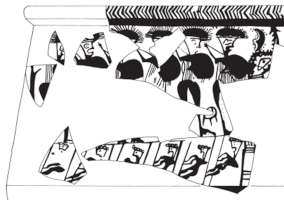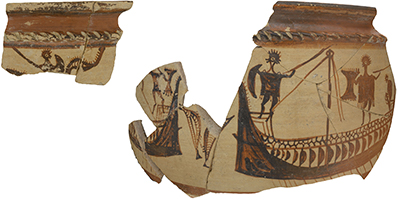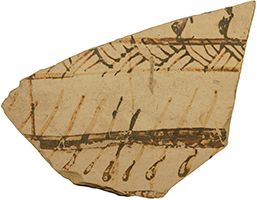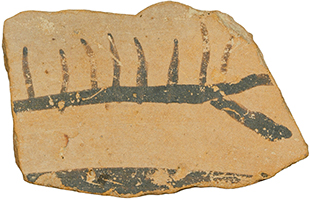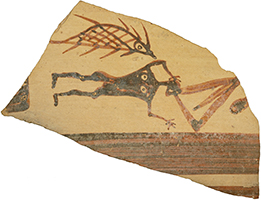Ship to the left. Vertical stempost with a zoomorphic figurehead of the same type as seen on the other Kynos ships. It has a recurving beak with spikes running the length of the upper side, starting from the beak and going all the way down the animal's "neck." The eye is large and almond-shaped, with a dark oversized pupil filling most of it. Part of the deck survives. Two oblique lines attached midway on the stempost are possibly mooring lines. Two stripes under the deck have been interpreted by Dakoronia as stanchions supporting the deck. This is unlikely based on the other parallels from Kynos. More plausible possibilities include the top of a stylized rower as on krater A91, or part of the decoration of a bulwark which typically runs below the deck on other ship depictions from Kynos.
Goat sacrifice on board
A93
LH IIIC middle
Pyrgos Livanaton (Kynos)
H (max): 10.6 cm; W (max): 8.7 cm
Sherd from a krater, white ware, plastic rope under the lip. Local fabric
Lamia Archaeological Museum
Dakoronia 2016, pl. CXIXa-b
The action takes place at the bow. A warrior stands facing left immediately behind the stempost. He is fully armed, carrying a leather shield of the so-called hetitic type in his right hand and a leaf-shaped spearhead in his left hand - a form which is rare but known in the Mycenaean repertoire. Both warriors have hedgehog helmets but appear to be otherwise naked. The second warrior faces right and appears to be kneeling on his right foot. He holds a goat by the horns with both hands. A double axe above the goat's head suggests that it is about to be sacrificed. There was thus at least one more person on board the ship. Typologically the axe belongs to a well-known Aegean type, with a similar bronze axe being known from Kynos itself from a probable sacrificial context dating to LH IIIB2. A thick band below the figurehead is difficult to interpret. Sacrifices to Poseidon performed by mariners in order to ensure safe sailing and calm seas are known from the Odyssey (Od. 3.187).
The unique scene portrays a sacrifice related to maritime rites either prior to departure or upon arrival. The mooring lines, if interpreted correctly as such, suggest that the ship was stationary.
Dakoronia, F. 2016. “Sacrifice on Board,” in E. Alram-Stern, F. Blakolmer, S. Deger-Jalkotzy, R. Laffineur & J. Weilhartner (eds), Metaphysis. Ritual, Myth and Symbolism in the Aegean Bronze Age. Proceedings of the 15th International Aegean Conference, Vienna, Institute for Oriental and European Archaeology, Aegean and Anatolia Department, Austrian Academy of Sciences and Institute of Classical Archaeology, University of Vienna, 22-25 April 2014. Aegaeum 39. Leuven: Peeters, pp. 387-392.


